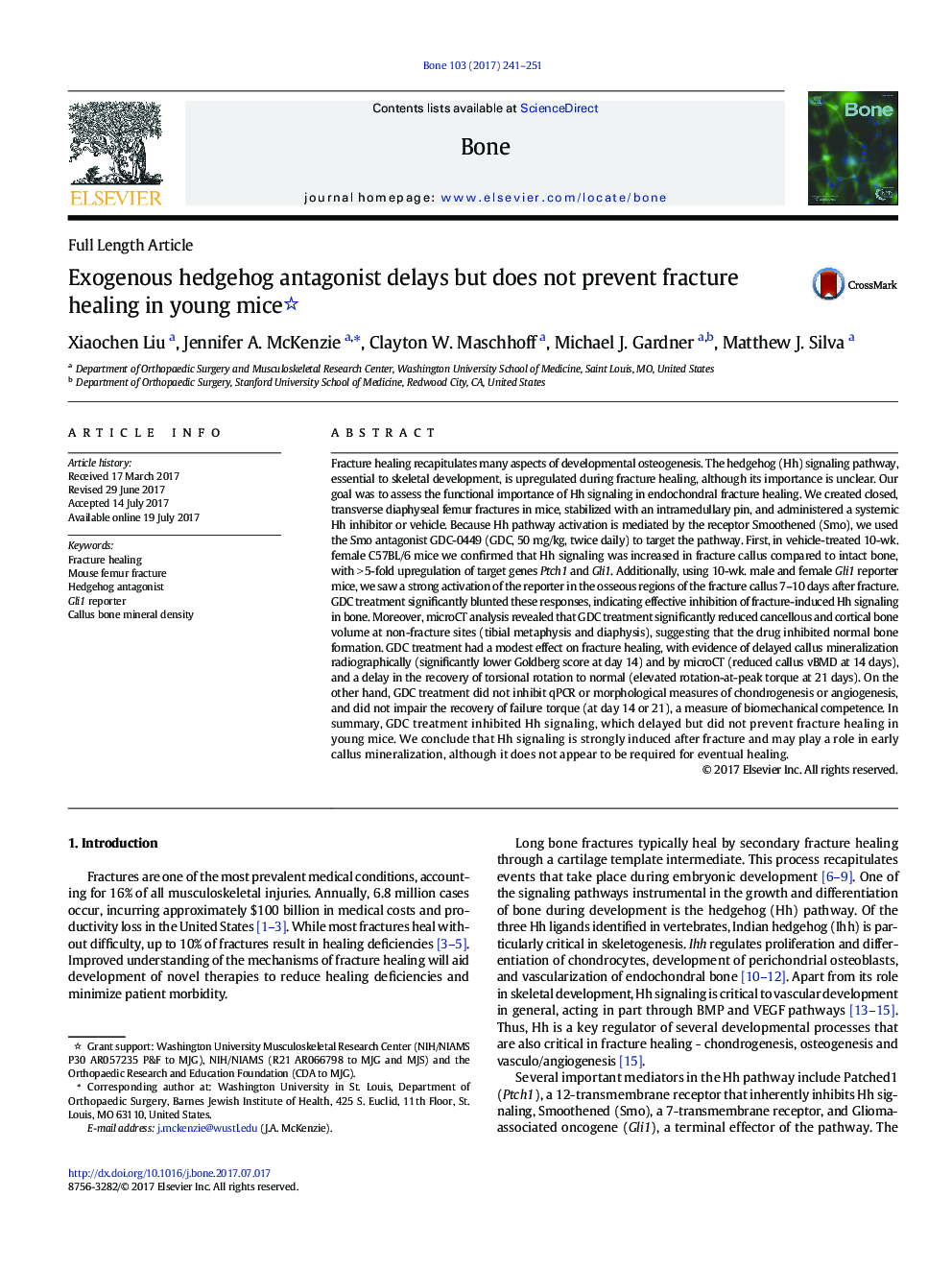| کد مقاله | کد نشریه | سال انتشار | مقاله انگلیسی | نسخه تمام متن |
|---|---|---|---|---|
| 5585277 | 1568116 | 2017 | 11 صفحه PDF | دانلود رایگان |
عنوان انگلیسی مقاله ISI
Exogenous hedgehog antagonist delays but does not prevent fracture healing in young mice
ترجمه فارسی عنوان
آنتاگونیست ساحلی بیضه تاخیری ندارد، اما در موشهای جوان جلوگیری از شکستگی شکست را ندارد
دانلود مقاله + سفارش ترجمه
دانلود مقاله ISI انگلیسی
رایگان برای ایرانیان
کلمات کلیدی
موضوعات مرتبط
علوم زیستی و بیوفناوری
بیوشیمی، ژنتیک و زیست شناسی مولکولی
زیست شناسی تکاملی
چکیده انگلیسی
Fracture healing recapitulates many aspects of developmental osteogenesis. The hedgehog (Hh) signaling pathway, essential to skeletal development, is upregulated during fracture healing, although its importance is unclear. Our goal was to assess the functional importance of Hh signaling in endochondral fracture healing. We created closed, transverse diaphyseal femur fractures in mice, stabilized with an intramedullary pin, and administered a systemic Hh inhibitor or vehicle. Because Hh pathway activation is mediated by the receptor Smoothened (Smo), we used the Smo antagonist GDC-0449 (GDC, 50Â mg/kg, twice daily) to target the pathway. First, in vehicle-treated 10-wk. female C57BL/6 mice we confirmed that Hh signaling was increased in fracture callus compared to intact bone, with >Â 5-fold upregulation of target genes Ptch1 and Gli1. Additionally, using 10-wk. male and female Gli1 reporter mice, we saw a strong activation of the reporter in the osseous regions of the fracture callus 7-10Â days after fracture. GDC treatment significantly blunted these responses, indicating effective inhibition of fracture-induced Hh signaling in bone. Moreover, microCT analysis revealed that GDC treatment significantly reduced cancellous and cortical bone volume at non-fracture sites (tibial metaphysis and diaphysis), suggesting that the drug inhibited normal bone formation. GDC treatment had a modest effect on fracture healing, with evidence of delayed callus mineralization radiographically (significantly lower Goldberg score at day 14) and by microCT (reduced callus vBMD at 14Â days), and a delay in the recovery of torsional rotation to normal (elevated rotation-at-peak torque at 21Â days). On the other hand, GDC treatment did not inhibit qPCR or morphological measures of chondrogenesis or angiogenesis, and did not impair the recovery of failure torque (at day 14 or 21), a measure of biomechanical competence. In summary, GDC treatment inhibited Hh signaling, which delayed but did not prevent fracture healing in young mice. We conclude that Hh signaling is strongly induced after fracture and may play a role in early callus mineralization, although it does not appear to be required for eventual healing.
ناشر
Database: Elsevier - ScienceDirect (ساینس دایرکت)
Journal: Bone - Volume 103, October 2017, Pages 241-251
Journal: Bone - Volume 103, October 2017, Pages 241-251
نویسندگان
Xiaochen Liu, Jennifer A. McKenzie, Clayton W. Maschhoff, Michael J. Gardner, Matthew J. Silva,
